
Wine Culture and Information since 2002 - Volume 22
 Wine Culture and Information since 2002 - Volume 22 |
|
Pinot NoirA grape requiring lots of mastery and a proper climate in order to make great wines. Pinot Noir is for many synonym of great class wines and it is the most used red berried grape for the production of sparkling wines including Champagne |
|
Pinot Noir is a rather bizarre grape and it certainly is among the most difficult grapes to cultivate and to vinify. It does not only require proper climate conditions in order to give its best in the vineyard, Pinot Noir also requires a high level of skill both from the agronomist and the wine maker. Pinot Noir is a difficult test for everyone trying to use this grape in order to make wine, a condition which is also true in its homeland and still considered the best area: Bourgogne. The difficulty in producing wines with Pinot Noir probably is one of the reasons about the division between the lovers of the beverage of Bacchus. For many Pinot Noir is capable of making wines of great class and elegance, probably like no other else, for others it is a grape capable of making emotionless wines. Maybe the ones who support it do that because they had the opportunity to taste great Pinot Noir wines, whereas the ones who cannot appreciate it, probably have always tasted mediocre Pinot Noirs, to tell the truth, the majority of wines produced with this grape. Pinot Noir is among the most ancient grapes of which exists historical evidences and its homeland is highly probable to be Bourgogne. It is believed Pinot Noir is being cultivated in Bourgogne for more than 2,000 years, it seems it was already present in the region before Roman invasions. Since those times Pinot Noir had a good notoriety and some famous authors, such as Pliny the Elder and Columella, mentioned the grape in their works. Pinot Noir is a variety defined as genetically unstable, that is it can easily change into other varieties. It is believed there are more than 1,000 different clonal varieties belonging to the family of Pinot, of which the most renowned ones are Pinot Blanc, Pinot Gris and Pinot Meunier, now considered as specific varieties. Pinot Noir's easiness of mutation represents a critical factor for its cultivation which is moreover added to the necessity of a cool climate in order to allow a slow ripeness. The cultivation of Pinot Noir and the subsequent production of wine always represents a challenge and it is not by chance high quality wines produced with this grape are pretty few, whereas are pretty common wines of mediocre, or even low, quality.
Bourgogne is to be considered as the best territory for Pinot Noir and in particular Côte d'Or, from which are certainly coming the best wines of the world produced with this grape. Pinot Noir is also common in Champagne - north from Bourgogne - where this grape is used for the production of the renowned sparkling wines. Pinot Noir is used in Champagne to give a fuller body to wine as well as increasing its aromatic complexity, last but not the least, it is also used alone without adding any other grape. Pinot Noir is the most used red berried grape for the production of sparkling wines, of which the most part is produced with the classic method and vinified as a white, that is by separating the skins from the must soon after pressing. Pinot Noir is also responsible for the enchanting color in rose sparkling wines, obtained by adding some red wine produced with this grape, as well as with rose wines produced with the bleeding technique (saignée in French). The name Pinot derives from the typical shape of the bunch of this grape, compact and small, resembling a pine cone. The berry of Pinot Noir has a thin skin, a modest coloring capacity, a pretty low content in tannins and a pretty high content in acids. Wines produced with this grape, because of the low contents of extracts in its thin skin, are relatively delicate and, again because of the composition of its berries, Pinot Noir does not allow a broad possibilities in creating many styles as opposed to other red berried grapes. Acidity is the critical factor in Pinot Noir and it must be preserved as much as possible in order not to compromise wine balance. The best way to keep Pinot Noir's acidity is to cultivate this grape in cool climate areas in order to allow a slow ripeness and an elegant and optimal development of aromas. For this reason Pinot Noir is not recommended in warm climate areas because it tends to ripen quickly while losing its precious acidity and developing pretty ordinary aromas. Pinot Noir's berries have a thin skin, a deep blue color and develop in small bunches. This grape is pretty susceptible to molds and it is a variety which ripens in advance as opposed to other red berried varieties and in Bourgogne harvesting takes place in the same period in which is being harvested Chardonnay. The yield of Pinot Noir is usually low and it is susceptible to many vine diseases, a condition that makes this grape more difficult to cultivate. Pinot Noir prefers limestone soils whereas clay soils, cool and wet, should be avoided. Because of the low content in tannins and in coloring pigments, wines produced with this grape are usually transparent with pretty pale hues, something which is truly different, for example, from the typical colors of wines produced with Cabernet Sauvignon or Sangiovese. In particularly bad years, some producers add some stems to the must in order to compensate the reduced quantity of tannins in the skins of Pinot Noir. The wine making styles for Pinot Noir can basically be summarized in two categories: red wines and sparkling wines. In the production of red wines, Pinot Noir is most of the cases vinified alone instead of being blended with other grapes. Despite red wines produced with Pinot Noir are frequently fermented or aged in cask, the contribution of wood is often very balanced thanks to the choice of casks made of not excessively toasted wood. As opposed to other grapes, such as Cabernet Sauvignon and Merlot, in Pinot Noir wines will hardly be perceived strong and dominant aromas of vanilla and toasted wood, this is because cask, when excessively used, tends to cover the fresh and elegant aromas of this grape. It should also be observed that the aging of Pinot Noir in cask contributes to the enrichment of the wine by adding the tannins passed from wood and therefore it can play a fundamental role in balance. In sparkling wines Pinot Noir is generally used for the production of classic method wines to which adds body and aromatic complexity. The longevity of red wines produced with Pinot Noir is pretty variable and it is strongly affected by quality. The average duration is usually from 2 and 8 years, sometimes 10 years as well, however it should be remembered that only the best Pinot Noirs, produced with high quality standards and criteria, can develop for 8-10 years.
|
||||||||
|
Because of the thin skin of its berries, Pinot Noir does not have remarkable coloring capacities, a characteristic which is well evident in the color and in the transparency of its red wines. The color in red wines produced with Pinot Noir can range from pretty pale hues to moderate intense ones, according to the quality of grapes and by maceration times. During youth the color will have ruby red hues that will evolve with aging into garnet red and therefore evident orange red hues. The transparency in Pinot Noir is always well evident: light will easily pass wine; something which is very different from the impenetrable transparencies of other varieties such as in many Cabernet Sauvignons. The presence of Pinot Noir in sparkling wines is frequently signaled by a deeper intensity of color. Whether in most of the cases sparkling wines have greenish yellow or pale straw yellow colors, when Pinot Noir is present, the hues gets deeper up to evident golden yellow colors. It should however be remembered that a deeper intensity of color in classic method sparkling wines can also be caused by long periods of aging on the lees and in the bottle. Finally, the pink color of many classic method sparkling wines - including Rose Champagne and Franciacorta Rosé - is because of the presence of wines produced with Pinot Noir vinified as red, added to a cuvée made of white wines, as well as a rose wine produced with the bleeding method.
|
|
Pinot Noir probably is the most renowned representative of fresh and clean aromas of fruit, capable of giving extremely elegant wines of indisputable class, a characteristic, to tell the truth, found only in high quality wines. Pinot Noir aromas are delicate and subtle - however well pronounced - and for this reason it is required an excellent skill for the wine maker in order not to cover or lose the elegant aromas of this grape. The use of casks made of very toasted wood certainly is the mistake every wine maker scrupulously avoids just because this would easily cover the aromas of Pinot Noir, except when it is wished to give the wine pronounced wood aromas. However most of the wines produced with Pinot Noir are fermented and aged in cask and the intelligent use of wood - the level of toasting and the aging period - is one of the factors which contributes to the elegance and class of these wines. Typical aromas of the fermentation and aging in cask will never be strong in Pinot Noir. It should however be observed that many producers prefer vinifying Pinot Noir in inert containers - such as stainless steel - however obtaining extremely refined and elegant results. Wines produced with Pinot Noir grape cultivated in areas with pretty cool climate, or harvested when they do not have reached optimal ripeness, are characterized by aromas that can also reminds herbaceous substances or vegetables, such as mint, tomato leaf and dill, however it will be clearly and evidently perceivable the fruity nature of the grape, in particular aromas of red berried fruits, such as cherry, raspberry, strawberry and blueberry. Wines produced in the areas having a warm climate, or grapes harvested at optimal ripeness, fruit aromas will be very evident and pronounced. There will be perceived the typical and characteristic aromas of Pinot Noir's fruits, such as cherry, raspberry and strawberry, as well as floral aromas such as rose and violet. The evolution of Pinot Noir in bottle develops very complex aromas in which the sensations of fruits will be transformed into jams and therefore, to the apex of aging, in aromas of undergrowth, leather, mushroom and game. The presence of Pinot Noir in white classic method sparkling wines is usually signaled by aromas of red berried fruit which will be added to the typical aromas of these wines. In rose classic method sparkling wines the typical fruit aromas of Pinot Noir will be very evident and predominant.
|
||||
|
The taste of wines produced with Pinot Noir is characterized by an evident acidity and, in case it was not properly controlled, it can also compromise balance. After all Pinot Noir is a grape notoriously difficult to cultivate and vinify, therefore requires particular attention and good capacities in cellar. Pinot Noir's acidity is strongly influenced both by the level of ripeness and the area in which it was cultivated, however, because of the low content in tannins, it will be the right acidity to contribute to the proper balance of the wine. No matter the aging in bottle generally makes Pinot Noir more round and velvety, acidity will be a characteristic that will accompany the entire evolution of these wines. One of the factors useful for balancing the evident acidity of grape is represented by alcohol that in wines produced with Pinot Noir is often pretty high. Roundness of the wine will also be determined by the aging in cask which will also contribute to increase its body.
|
|
Pinot Noir is a grape which is not easy to cultivate and to vinify in case the goal is the production of high quality wines. Considered as an international grape since many years, Pinot Noir is virtually spread in every wine making country of the world, appreciated by many as a superb example of elegance, indifferent to others because of its scarce color which makes it appear as a modest wine. It should however be observed that high quality wines produced with Pinot Noir are pretty few, whereas it is very easy to find wines produced with this grape that in the best cases could be defined as mediocre. The indisputable homeland of Pinot Noir is Bourgogne - and in particular Côte d'Or - where this grape is capable of giving its best in countless interpretations, also thanks to the climate conditions of the area, the mutability of the grape and the wine making tradition strongly based on the differences of the territory. In Côte de Nuits Pinot Noir wines usually are full bodied and complex, with intriguing mineral and spicy hints. In the neighboring Côte de Beaune it is the fruit character of the grape to prevail in the style of these wines, rounder and with a faster aging. In other areas of Burgundy, good examples of Pinot Noir can be found in the village of Pommard; other interesting examples, with different qualities, are the wines produced in the Côte Chalonnaise, Mercurey and Givry. In France Pinot Noir is also present in Champagne, where it is being used for the production of the renowned sparkling wines, in the Loire Valley and in Alsace. In other areas of Europe Pinot Noir produces good examples in Switzerland - in particular at Valais and Neuchâtel, where it is known as Blauburgunder - whereas in Austria are being produced good Pinot Noirs in the area of Burgenland. In Germany this grape is pretty common, known as Blauburgunder, mainly in the areas of Palatinate (Pfalz), Franconia and Ahr, moreover Pinot Noir is pretty successful in Romania as well. In Italy the best examples of wines produced with Pinot Noir come from the North-East area and in particular from Alto-Adige, however good examples can also be found in Tuscany, Umbria and in the Oltrepò Pavese where it is also vinified as white. In the so called New World Pinot Noir is having a good attention and the best examples are from, as far as United States of America is concerned, from Oregon - certainly the best American area for Pinot Noir - and from the coolest areas of California, such as Russian River, Carneros (mainly used for the production of classic method sparkling wines), Santa Barbara (in particular the areas of Santa Maria and Santa Ynez) and Monterey. No matter the climate of Argentina is too hot for Pinot Noir, good examples are produced in the Río Negro area, whereas in South Africa this grape has produced few but good examples, in particular in the cool Walker Bay. In Australia most of the Pinot Noir is produced in Victoria, in particular at Yarra Valley. The cool climate of New Zealand allows the production of excellent Pinot Noir wines, in particular in the areas of Marlborough, Martinborough and Central Otago.
|
Wines of the Month |
|
|
|
Score legend Prices are to be considered as indicative. Prices may vary according to the country or the shop where wines are bought |
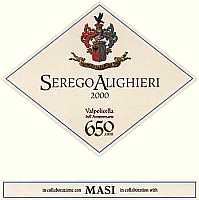
|
|
Valpolicella Classico Superiore Serego Alighieri 2000 |
|
| Masi (Italy) | |
| Grapes: Corvina (70%), Rondinella (20%), Molinara (10%) | |
| Price: € 18,50 | Score: |
| This wine shows an intense ruby red color and nuances of garnet red, little transparency. The nose reveals intense, clean, pleasing and refined aromas which start with hints of black cherry, plum jam and blackberry followed by aromas of blueberry, violet, vanilla, licorice, tobacco and hints of coriander. In the mouth has good correspondence to the nose, a slightly tannic attack and however well balanced by alcohol, good body, intense flavors, good tannins, pleasing roundness. The finish is persistent with flavors of black cherry, plum and blackberry. A well made wine. This Valpolicella ages for 24 months in cask, of which 6 in cask of cherry wood, and for at least 6 months in bottle. | |
| Food Match: Roasted meat, Braised and stewed meat with mushrooms, Hard cheese | |
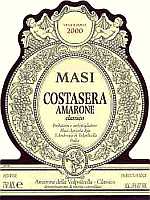
|
|
Amarone della Valpolicella Classico Costasera 2000 |
|
| Masi (Italy) | |
| Grapes: Corvina (70%), Rondinella (25%), Molinara (5%) | |
| Price: € 25,90 | Score: |
| This wine shows an intense ruby red color and nuances of garnet red, little transparency. The nose denotes intense, clean, pleasing and refined aromas which start with hints of plum, black cherry and dried violet followed by aromas of blackberry, tobacco, licorice, cocoa, vanilla and hints of leather. In the mouth has good correspondence to the nose, a slightly tannic attack and however balanced by alcohol, full body, intense flavors, good tannins. The finish is persistent with good flavors of plum, black cherry and blackberry. A well made wine. This Amarone ages for 24 months in cask followed by at least 4 months of aging in bottle. | |
| Food Match: Braised and stewed meat, Roasted meat, Game, Hard cheese | |
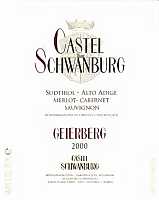
|
|
Alto Adige Merlot-Cabernet Sauvignon Castel Schwanburg Geierberg 2000 |
|
| Castel Schwanburg (Italy) | |
| Grapes: Merlot, Cabernet Sauvignon | |
| Price: € 18,80 | Score: |
| This wine shows an intense ruby red color and nuances of ruby red, little transparency. The nose denotes intense, clean, pleasing, refined and elegant aromas that start with hints of black cherry, plum and blackberry followed by aromas of blueberry, raspberry, licorice, black currant, violet, vanilla and hints of black pepper. In the mouth has good correspondence to the nose, a slightly tannic attack and however well balanced by alcohol, good body, intense flavors, good tannins. The finish is persistent with flavors of black cherry, plum and raspberry. A well made wine. Geierberg ages in cask for 12 months. | |
| Food Match: Roasted meat, Stewed and braised meat, Hard cheese | |
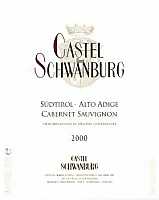
|
|
Alto Adige Cabernet Sauvignon Castel Schwanburg 2000 |
|
| Castel Schwanburg (Italy) | |
| Grapes: Cabernet Sauvignon (90%), Cabernet Franc, Petit Verdot (10%) | |
| Price: € 25,00 | Score: |
| This wine shows a brilliant ruby red color and nuances of ruby red, little transparency. The nose reveals good personality with intense, clean, pleasing, refined and elegant aromas which start with hints of plum, vanilla and black currant followed by aromas of black cherry, blackberry, violet, licorice, tobacco, cinnamon, bell pepper and hints of chocolate, eucalyptus and nutmeg. In the mouth has good correspondence to the nose, a slightly tannic attack and however well balanced by alcohol, good body, intense flavors, good tannins, agreeable. The finish is persistent with good flavors of plum, black currant and black cherry. A well made wine. This Cabernet Sauvignon ages for 18 months in barrique. | |
| Food Match: Roasted meat, Braised and stewed meat, Game, Hard cheese | |
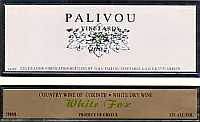
|
|
Palivou Vineyards White Fox 2003 |
|
| Palivos Estate (Greece) | |
| Grapes: Roditis | |
| Price: € 3,15 | Score: |
| The wine shows a brilliant greenish yellow color and nuances of greenish yellow, very transparent. The nose denotes intense, clean, pleasing and refined aromas which start with hints of peach, litchi and broom followed by aromas of acacia, banana, pineapple, lemon grass, apple and pear. In the mouth has good correspondence to the nose, a crisp attack and however balanced, delicate, intense flavors. The finish is persistent with flavors of pineapple and pear. | |
| Food Match: Dairy products, Crustacean appetizers, Risotto and pasta with crustaceans | |
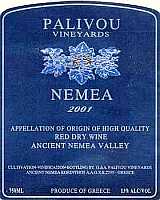
|
|
Nemea 2001 |
|
| Palivos Estate (Greece) | |
| Grapes: Agiorgitiko | |
| Price: € 4,93 | Score: |
| This wine shows an intense ruby red color and nuances of ruby red, moderate transparency. The nose denotes intense, clean, pleasing and refined aromas that start with hints of plum, violet and vanilla followed by aromas of licorice, black currant, black cherry and hints of chocolate and eucalyptus. In the mouth has good correspondence to the nose, a slightly tannic attack and however balanced by alcohol, good body, intense flavors, good tannins. The finish is persistent with flavors of plum, black cherry and black currant. This wine ages for 18 months in cask followed by 12 months of aging in bottle. | |
| Food Match: Stewed meat, Roasted meat, Hard cheese | |
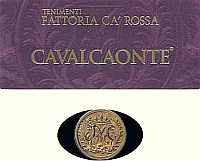
|
|
Cavalcaonte 2003 |
|
| Fattoria Ca' Rossa (Italy) | |
| Grapes: Barbera | |
| Price: € 7,00 | Score: |
| The wine shows an intense ruby red color and nuances of ruby red, little transparency. The nose denotes intense, clean, pleasing and refined aromas which start with hints of black cherry, blackberry and plum followed by aromas of blueberry, violet and raspberry. In the mouth has good correspondence to the nose, a slightly tannic attack and however well balanced by alcohol, good body, intense flavors, good tannins, agreeable. The finish is persistent with flavors of plum, blueberry and black cherry. Cavalcaonte ages in steel tanks. | |
| Food Match: Broiled meat and barbecue, Roasted meat, Hard cheese | |
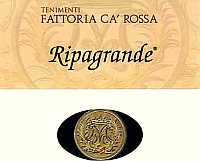
|
|
Sangiovese di Romagna Superiore Riserva Ripagrande 2001 |
|
| Fattoria Ca' Rossa (Italy) | |
| Grapes: Sangiovese | |
| Price: € 15,50 | Score: |
| This wine shows an intense ruby red color and nuances of garnet red, little transparency. The nose reveals intense, clean, pleasing and refined aromas which start with hints of black cherry and violet followed by aromas of blackberry, blueberry, vanilla, licorice and cocoa. In the mouth has good correspondence to the nose, a slightly tannic attack and however well balanced by alcohol, good body, intense flavors, good tannins. The finish is persistent with flavors of plum, black cherry and blueberry. This Sangiovese ages for 24 months in barrique and followed by 12 months of aging in bottle. | |
| Food Match: Braised and stewed meat, Roasted meat, Hard cheese | |
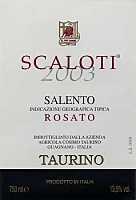
|
|
Scaloti 2003 |
|
| Cosimo Taurino (Italy) | |
| Grapes: Negroamaro | |
| Price: € 7,00 | Score: |
| The wine shows a pale cherry pink and nuances of onion skin pink, transparent. The nose denotes intense, clean and pleasing aromas which start with hints of black cherry and raspberry followed by aromas of strawberry, peach and cyclamen. In the mouth has good correspondence to the nose, a pretty crisp attack and pleasing roundness, however balanced by alcohol, delicate, intense flavors. The finish is persistent with flavors of raspberry and strawberry. | |
| Food Match: Appetizers, Cold cuts, Dairy products, Pasta and risotto with vegetables, Fish soups | |
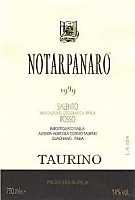
|
|
Notarpanaro 1999 |
|
| Cosimo Taurino (Italy) | |
| Grapes: Negroamaro (85%), Malvasia Nera (15%) | |
| Price: € 14,00 | Score: |
| The wine shows an intense ruby red color and nuances of garnet red, little transparency. The nose reveals good personality with intense, clean, pleasing and refined aromas which start with hints of plum jam and black cherry jam followed by aromas of carob, dried violet, tobacco, vanilla, licorice and hints of walnut husk and cinnamon. In the mouth has good correspondence to the nose, a slightly tannic attack and however balanced, good body, intense flavors, good tannins, agreeable. The finish is persistent with flavors of plum jam and black cherry jam. | |
| Food Match: Stewed meat with mushrooms, Roasted meat, Broiled meat and barbecue, Hard cheese | |
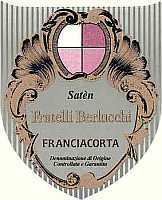
|
|
Franciacorta Satèn 2000 |
|
| Fratelli Berlucchi (Italy) | |
| Grapes: Chardonnay (80%), Pinot Blanc (20%) | |
| Price: € 22,00 | Score: |
| This wine shows a brilliant straw yellow color and nuances of straw yellow, very transparent, good effervescence, fine and persistent perlage. The nose reveals good personality with intense, clean, pleasing and refined aromas that start with hints of plum, grapefruit and bread crust followed by aromas of hawthorn, pineapple, banana, yeast, litchi, hazelnut and apple. In the mouth has good correspondence to the nose, a crisp and effervescent attack, however well balanced, good body, intense flavors, agreeable. The finish is persistent with flavors of banana, litchi and grapefruit. This Franciacorta ages for at least 37 months on its lees followed by 2-3 months of aging in bottle. | |
| Food Match: Pasta and risotto with fish and crustaceans, Roasted fish, Stewed fish, Stuffed pasta | |
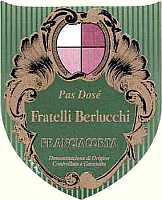
|
|
Franciacorta Pas Dosé 2000 |
|
| Fratelli Berlucchi (Italy) | |
| Grapes: Chardonnay (80%), Pinot Blanc, Pinot Noir (20%) | |
| Price: € 21,50 | Score: |
| This Franciacorta shows a pale golden yellow color and nuances of straw yellow, very transparent, good effervescence, fine and persistent perlage. The nose denotes intense, clean, pleasing and refined aromas which start with hints of pear and apple followed by aromas of yeast, hawthorn, broom, acacia, pineapple, toasted bread, hazelnut and grapefruit. In the mouth has good correspondence to the nose, a crisp and effervescent attack, however well balanced, good body, intense flavors. The finish is persistent with flavors of apple and pear. This Franciacorta ages on its lees for at least 37 months and ages in bottle for 2-3 months. | |
| Food Match: Fish and crustacean appetizers, Pasta and risotto with fish, vegetables and crustaceans, Sauteed white meat, Sauteed fish | |
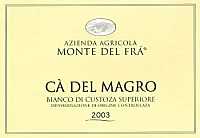
|
|
Bianco di Custoza Superiore Cà del Magro 2003 |
|
| Monte del Frà (Italy) | |
| Grapes: Garganega (50%), Trebbiano Toscano (10%), Tocai (10%), Cortese (15%), Chardonnay, Riesling, Sauvignon Blanc (15%) | |
| Price: € 9,00 | Score: |
| This wine shows a brilliant greenish yellow color and nuances of greenish yellow, very transparent. The nose reveals intense, clean and pleasing aromas which start with hints of apple, pear and hawthorn followed by aromas of pineapple, broom, wistaria, almond and hints of vanilla. In the mouth has good correspondence to the nose, a crisp attack and however balanced by alcohol, good body, intense flavors, agreeable. The finish is persistent with flavors of pear and apple. Chardonnay, Sauvignon Blanc and Riesling grapes used for the production of this wine are fermented and aged in barrique whereas the rest in steel tanks. | |
| Food Match: Pasta and risotto with fish and crustaceans, Broiled fish, Sauteed white meat with mushrooms | |
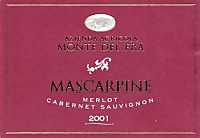
|
|
Mascarpine 2001 |
|
| Monte del Frà (Italy) | |
| Grapes: Cabernet Sauvignon (80%), Merlot (20%) | |
| Price: € 11,00 | Score: |
| The wine shows an intense ruby red color and nuances of garnet red, little transparency. The nose reveals good personality with intense, clean, pleasing and elegant aromas that start with hints of cherry, raspberry and rose followed by aromas of strawberry, blueberry, plum, blackberry, violet and vanilla. In the mouth has good correspondence to the nose, a slightly tannic attack and however balanced by alcohol, good body, intense flavors, good tannins, agreeable. The finish is persistent with flavors of blueberry, raspberry and black cherry. A well made wine. Mascarpine ages in cask for at least 12 months followed by an aging in bottle of at least 6 months. | |
| Food Match: Roasted meat, Stewed and braised meat, Hard cheese | |
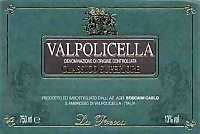
|
|
Valpolicella Classico Superiore La Preosa 2001 |
|
| Boscaini Carlo (Italy) | |
| Grapes: Corvina (50%), Corvinone (40%), Rondinella (10%) | |
| Price: € 7,80 | Score: |
| The wine shows a brilliant ruby red color and nuances of garnet red, moderate transparency. The nose denotes intense, clean and pleasing aromas that start with hints of plum jam, black cherry and violet followed by aromas of blackberry, licorice, vanilla and hints of cinnamon. In the mouth has good correspondence to the nose, a slightly tannic attack and however balanced, good body, intense flavors, good tannins. The finish is persistent with flavors of black cherry and plum. This Valpolicella ages for 18 months in cask followed by 8 months of aging in bottle. | |
| Food Match: Broiled meat and barbecue, Stewed meat, Hard cheese | |
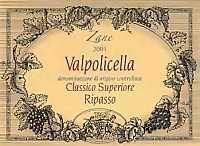
|
|
Valpolicella Classico Superiore Ripasso Zane 2001 |
|
| Boscaini Carlo (Italy) | |
| Grapes: Corvina (50%), Corvinone (40%), Rondinella (10%) | |
| Price: € 12,50 | Score: |
| This wine shows a brilliant ruby red color and nuances of garnet red, moderate transparency. The nose reveals intense, clean and pleasing aromas that start with hints of plum jam and black cherry jam followed by aromas of cyclamen, violet, licorice, tobacco, vanilla and cinnamon. In the mouth has good correspondence to the nose, a slightly tannic attack and pleasing roundness, however balanced, good body, intense flavors, good tannins, agreeable. The finish is persistent with flavors of plum jam and black cherry jam. This Valpolicella ages for 18 months in cask and for 8 months in bottle. | |
| Food Match: Roasted meat, Stewed meat with mushrooms, Hard cheese | |
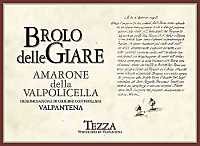
|
|
Amarone della Valpolicella - Valpantena Brolo delle Giare 2000 |
|
| Tezza (Italy) | |
| Grapes: Corvina (80%), Rondinella (10%), Croatina (10%) | |
| Price: € 40,00 | Score: |
| This Amarone shows an intense ruby red color and nuances of garnet red, little transparency. The nose reveals intense, clean, pleasing, refined and elegant aromas that start with hints of blackberry, plum and black cherry followed by aromas of blueberry, dried violet, licorice, tobacco, vanilla, chocolate and hints of black pepper and enamel. In the mouth has good correspondence to the nose, a slightly tannic attack and pleasing roundness, however well balanced by alcohol, full body, intense flavors, good tannins. The finish is persistent with good flavors of blackberry, plum and black cherry. A well made wine. This Amarone ages for 2 years in barrique followed by one year of aging in bottle. | |
| Food Match: Braised and stewed meat, Roasted meat, Game, Hard cheese | |
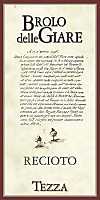
|
|
Recioto della Valpolicella Brolo delle Giare 2000 |
|
| Tezza (Italy) | |
| Grapes: Corvina (80%), Rondinella (10%), Croatina (10%) | |
| Price: € 19,80 - 375 ml | Score: |
| The wine shows an intense ruby red color and nuances of garnet red, little transparency. The nose reveals intense, clean, pleasing, refined and elegant aromas which start with hints of blackberry jam and black cherry jam followed by aromas of plum jam, raspberry, licorice, mace, cocoa, vanilla, pink pepper, dried violet and hints of enamel. In the mouth has good correspondence to the nose, a sweet and slightly tannic attack, however well balanced by alcohol, full body, intense flavors, good tannins. The finish is persistent with flavors of blackberry jam and black cherry jam. A well made wine. This Recioto ages for 12 months in barrique followed by 6 months of aging in bottle. | |
| Food Match: Hard and piquant cheese, Jam tarts, Chocolate | |
|
||||||||
|
DiWineTaste Polls
|
| |||||||
Privacy Policy | |||||||


| Copyright © 2002-2024 Antonello Biancalana, DiWineTaste - All rights reserved |
| All rights reserved under international copyright conventions. No part of this publication and of this WEB site may be
reproduced or utilized in any form or by any means, electronic or mechanical, without permission in writing from DiWineTaste. |